The Influence of Multi-Sensory Perception on Public Activity in Urban Street Spaces: An Empirical Study Grounded in Landsenses Ecology
Abstract
1. Introduction
2. Method
2.1. Study Area and Sampling Points
2.2. Data on Street Spatial Features
2.3. Public Survey Data
2.3.1. Landsenses Evaluation Indices of Urban Streets
2.3.2. Questionnaire Design
2.4. Construction of the Conceptual Model
3. Results
3.1. Basic Characteristics of Urban Street Spatial Features
3.2. Sample Statistics
3.3. Relationship Between Street Spatial Characteristics and Behavioral Traits
3.4. Influence of Street Spatial Characteristics on Behavior Traits
3.4.1. Factors Influencing the Impact of Street Spatial Characteristics on Behavioral Traits
3.4.2. The Impact Pathways of Street Spatial Characteristics on Behavioral Traits
4. Discussion
4.1. The Relationship Between Street Spatial Characteristics and Behavioral Traits
4.2. Pathways Through Which Street Spatial Characteristics Influence Behavior
4.3. Research Limitations and Future Studies
5. Conclusions
- (1)
- Among street spatial characteristics, water elements have the most substantial impact on public behavioral traits. Areas with higher Water Surface Ratios (WSRs) promote nature-based activities, while higher Waterfront Density (WD) fosters social and physical activities, such as chatting, running, and walking dogs.
- (2)
- Roads and water features influence behaviors directly and indirectly through multi-sensory perception, particularly auditory, olfactory, and tactile modalities. Conversely, buildings and green spaces affect behaviors primarily through sensory pathways, with certain characteristics, such as Building Density (BD) and Green Rate (GR), having negative impacts.
- (3)
- Olfactory perception surpasses other sensory modalities in influencing public behavior. Unpleasant odors significantly deter public engagement, even in visually and acoustically appealing areas, highlighting the importance of managing odor sources in urban environments.
Author Contributions
Funding
Data Availability Statement
Acknowledgments
Conflicts of Interest
References
- UN General Assembly. Resolution Adopted by the General Assembly: Transforming Our World: The 2030 Agenda for Sustainable Development A/RES/70/1; United Nations: New York, NY, USA, 2015. [Google Scholar]
- Lowe, M.; Adlakha, D.; Sallis, J.F.; Salvo, D.; Cerin, E.; Moudon, A.V.; Higgs, C.; Hinckson, E.; Arundel, J.; Boeing, G.; et al. City planning policies to support health and sustainability: An international comparison of policy indicators for 25 cities. Lancet Glob. Health 2022, 10, e882–e894. [Google Scholar] [CrossRef] [PubMed]
- Ye, C.; Schröder, P.; Yang, D.; Chen, M.; Cui, C.; Zhuang, L. Toward healthy and liveable cities: A new framework linking public health to urbanization. Environ. Res. Lett. 2022, 17, 064035. [Google Scholar] [CrossRef]
- Rezvanipour, S.; Hassan, N.; Ghaffarianhoseini, A.; Danaee, M. Why does the perception of street matter? A dimensional analysis of multisensory social and physical attributes shaping the perception of streets. Arch. Sci. Rev. 2021, 64, 359–373. [Google Scholar] [CrossRef]
- Abusaada, H.; Elshater, A. Effect of people on placemaking and affective atmospheres in city streets. Ain Shams Eng. J. 2021, 12, 3389–3403. [Google Scholar] [CrossRef]
- Tang, J.; Long, Y. Measuring visual quality of street space and its temporal variation: Methodology and its application in the Hutong area in Beijing. Landsc. Urban Plan. 2019, 191, 103436. [Google Scholar] [CrossRef]
- Lu, Y. Using Google Street View to investigate the association between street greenery and physical activity. Landsc. Urban Plan. 2019, 191, 103435. [Google Scholar] [CrossRef]
- Salazar-Miranda, A.; Heine, C.; Duarte, F.; Schechtner, K.; Ratti, C. Measuring the impact of slow zones on street life using social media. Cities 2022, 131, 104010. [Google Scholar] [CrossRef]
- Lu, Y.; Sarkar, C.; Xiao, Y. The effect of street-level greenery on walking behavior: Evidence from Hong Kong. Soc. Sci. Med. 2018, 208, 41–49. [Google Scholar] [CrossRef]
- Song, J.; Zhou, S.; Kwan, M.-P.; Liang, S.; Lu, J.; Jing, F.; Wang, L. The effect of eye-level street greenness exposure on walking satisfaction: The mediating role of noise and PM2.5. Urban For. Urban Green. 2022, 77, 127752. [Google Scholar] [CrossRef]
- Liu, J.; Wei, Y.; Lu, S.; Wang, R.; Chen, L.; Xu, F. The elderly’s preference for the outdoor environment in Fragrant Hills Nursing Home, Beijing: Interpreting the visual-behavioural relationship. Urban For. Urban Green. 2021, 64, 127242. [Google Scholar] [CrossRef]
- Ki, D.; Lee, S. Analyzing the effects of Green View Index of neighborhood streets on walking time using Google Street View and deep learning. Landsc. Urban Plan. 2021, 205, 103920. [Google Scholar] [CrossRef]
- Jin, L.; Lu, W.; Sun, P. Preference for Street Environment Based on Route Choice Behavior While Walking. Front. Public Health 2022, 10, 880251. [Google Scholar] [CrossRef]
- Yan, Q.; Luo, S.; Jiang, J. Urban Residents’ Preferred Walking Street Setting and Environmental Factors: The Case of Chengdu City. Buildings 2023, 13, 1199. [Google Scholar] [CrossRef]
- Elzeni, M.M.; Elmokadem, A.A.; Badawy, N.M. Impact of urban morphology on pedestrians: A review of urban approaches. Cities 2022, 129, 103840. [Google Scholar] [CrossRef]
- Yao, W.; Yun, J.; Zhang, Y.; Meng, T.; Mu, Z. Usage behavior and health benefit perception of youth in urban parks: A case study from Qingdao, China. Front. Public Health 2022, 10, 923671. [Google Scholar] [CrossRef] [PubMed]
- Li, J.; Huang, Z.; Zhu, Z.; Ding, G. Coexistence Perspectives: Exploring the impact of landscape features on aesthetic and recreational values in urban parks. Ecol. Indic. 2024, 162, 112043. [Google Scholar] [CrossRef]
- Mehrabian, A.; Russell, J.A. An Approach to Environment Psychology; MIT: Cambridge, MA, USA, 1974. [Google Scholar]
- Zhao, J.; Liu, X.; Dong, R.; Shao, G. Landsenses ecology and ecological planning toward sustainable development. Int. J. Sustain. Dev. World Ecol. 2016, 23, 293–297. [Google Scholar] [CrossRef]
- He, S.; Chen, D.; Shang, X.; Han, L.; Shi, L. Resident Satisfaction of Urban Green Spaces through the Lens of Landsenses Ecology. Int. J. Environ. Res. Public Health 2022, 19, 15242. [Google Scholar] [CrossRef] [PubMed]
- Guo, X.; Liu, J.; Chen, Z.; Hong, X.-C. Harmonious Degree of Sound Sources Influencing Visiting Experience in Kulangsu Scenic Area, China. Forests 2023, 14, 138. [Google Scholar] [CrossRef]
- Wei, Y.; Hou, Y. Forest Visitors’ Multisensory Perception and Restoration Effects: A Study of China’s National Forest Parks by Introducing Generative Large Language Model. Forests 2023, 14, 2412. [Google Scholar] [CrossRef]
- Li, S.; Chen, T.; Chen, F.; Mi, F. How Does the Urban Forest Environment Affect the Psychological Restoration of Residents? A Natural Experiment in Environmental Perception from Beijing. Forests 2023, 14, 1986. [Google Scholar] [CrossRef]
- Mehta, V.; Bosson, J.K. Revisiting Lively Streets: Social Interactions in Public Space. J. Plan. Educ. Res. 2018, 41, 160–172. [Google Scholar] [CrossRef]
- Gao, W.; Jia, M.; Zhao, M.; Gao, Y.; Meng, H. Review of Progress and Quantitative Measurement Methods of Research on Street Space. City Plan. Rev. 2022, 46, 106–114. [Google Scholar]
- Wang, Y.; Zhou, Q.; Yang, X.; Nan, J. Research on Process Framework and Evaluation System of Urban Public Spatial Perception. Urban Plan. Int. 2022, 37, 80–89. [Google Scholar]
- Zhao, J.; Yan, Y.; Deng, H.; Liu, G.; Dai, L.; Tang, L.; Shi, L.; Shao, G. Remarks about landsenses ecology and ecosystem services. Int. J. Sustain. Dev. World Ecol. 2020, 27, 196–201. [Google Scholar] [CrossRef]
- Liu, C.; Tang, L.; Yan, J.; Ouyang, J. Direct and indirect effects of multisensory modalities on visitor’s thermal comfort in an urban park in a humid-hot climate. Int. J. Sustain. Dev. World Ecol. 2023, 30, 319–328. [Google Scholar] [CrossRef]
- Wu, Y.; Tang, L.; Huang, C.; Shao, G.; Hou, J.; Sabel, C.E. Enhancing human well-being through cognitive and affective pathways linking landscape sensation to cultural ecosystem services. Landsc. Ecol. 2024, 39, 175. [Google Scholar] [CrossRef]
- Mao, Y.; Xia, T.; Hu, F.; Chen, D.; He, Y.; Bi, X.; Zhang, Y.; Cao, L.; Yan, J.; Hu, J.; et al. The greener the living environment, the better the health? Examining the effects of multiple green exposure metrics on physical activity and health among young students. Environ. Res. 2024, 250, 118520. [Google Scholar] [CrossRef]
- Shao, J.; Qiu, Q.; Qian, Y.; Tang, L. Optimal visual perception in land-use planning and design based on landsenses ecology. Int. J. Sustain. Dev. World Ecol. 2020, 27, 233–239. [Google Scholar] [CrossRef]
- Zheng, T.; Yan, Y.; Lu, H.; Pan, Q.; Zhu, J.; Wang, C.; Zhang, W.; Rong, Y.; Zhan, Y. Visitors’ perception based on five physical senses on ecosystem services of urban parks from the perspective of landsenses ecology. Int. J. Sustain. Dev. World Ecol. 2020, 27, 214–223. [Google Scholar] [CrossRef]
- Li, Y.; Li, M.; Xu, Y.; Tao, J. “Interface-element-perception” model to evaluation of urban sidewalk visual landscape in the core area of Beijing. Front. Arch. Res. 2024, 13, 960–977. [Google Scholar] [CrossRef]
- Liu, J.; Yang, L.; Xiong, Y.; Yang, Y. Effects of soundscape perception on visiting experience in a renovated historical block. Build. Environ. 2019, 165, 106375. [Google Scholar] [CrossRef]
- Ba, M.; Kang, J. Perception and Behaviour under the Audio-olfactory Interaction in Urban Public Open Spaces. South Archit. 2022, 10, 19–29. [Google Scholar]
- Asadi-Shekari, Z.; Moeinaddini, M.; Aghaabbasi, M.; Cools, M.; Shah, M.Z. Exploring effective micro-level items for evaluating inclusive walking facilities on urban streets (applied in Johor Bahru, Malaysia). Sustain. Cities Soc. 2019, 49, 101563. [Google Scholar] [CrossRef]
- Hair, J.F.; Risher, J.J.; Sarstedt, M.; Ringle, C.M. When to use and how to report the results of PLS-SEM. Eur. Bus. Rev. 2019, 31, 2–24. [Google Scholar] [CrossRef]
- Hair, J.F.; Sarstedt, M.; Ringle, C.M.; Sharma, P.N.; Liengaard, B.D. Going beyond the untold facts in PLS–SEM and moving forward. Eur. J. Mark. 2024, 58, 81–106. [Google Scholar] [CrossRef]
- Zhang, Y.; Chen, N.; Du, W.; Li, Y.; Zheng, X. Multi-source sensor based urban habitat and resident health sensing: A case study of Wuhan, China. Build. Environ. 2021, 198, 107883. [Google Scholar] [CrossRef]
- White, M.; Smith, A.; Humphryes, K.; Pahl, S.; Snelling, D.; Depledge, M. Blue space: The importance of water for preference, affect, and restorativeness ratings of natural and built scenes. J. Environ. Psychol. 2010, 30, 482–493. [Google Scholar] [CrossRef]
- Curl, A.; Mason, P. Neighbourhood perceptions and older adults’ wellbeing: Does walking explain the relationship in deprived urban communities? Transp. Res. Part A Policy Pract. 2019, 123, 119–129. [Google Scholar] [CrossRef]
- Zang, P.; Qiu, H.; Zhang, H.; Chen, K.; Xian, F.; Mi, J.; Guo, H.; Qiu, Y.; Liao, K. The built environment’s nonlinear effects on the elderly’s propensity to walk. Front. Ecol. Evol. 2023, 11, 1103140. [Google Scholar] [CrossRef]
- Bertram, C.; Rehdanz, K. The role of urban green space for human well-being. Ecol. Econ. 2015, 120, 139–152. [Google Scholar] [CrossRef]
- Lin, W.; Chen, Q.; Jiang, M.; Zhang, X.; Liu, Z.; Tao, J.; Wu, L.; Xu, S.; Kang, Y.; Zeng, Q. The effect of green space behaviour and per capita area in small urban green spaces on psychophysiological responses. Landsc. Urban Plan. 2019, 192, 103637. [Google Scholar] [CrossRef]
- Li, Y.; Yabuki, N.; Fukuda, T. Exploring the association between street built environment and street vitality using deep learning methods. Sustain. Cities Soc. 2022, 79, 103656. [Google Scholar] [CrossRef]
- Vichiensan, V.; Nakamura, K. Walkability Perception in Asian Cities: A Comparative Study in Bangkok and Nagoya. Sustainability 2021, 13, 6825. [Google Scholar] [CrossRef]
- Sun, X.; Wang, L.; Wang, F.; Soltani, S. Behaviors of seniors and impact of spatial form in small-scale public spaces in Chinese old city zones. Cities 2020, 107, 102894. [Google Scholar] [CrossRef]
- Zeng, Q.; Wu, H.; Zhou, L.; Huang, G.; Li, Y.; Dewancker, B.J. Toward pedestrian-friendly cities: Nonlinear and interaction effects of building density on pedestrian volume. J. Transp. Geogr. 2024, 119, 103954. [Google Scholar] [CrossRef]
- Liu, J.; Xiong, Y.; Wang, Y.; Luo, T. Soundscape effects on visiting experience in city park: A case study in Fuzhou, China. Urban For. Urban Green. 2018, 31, 38–47. [Google Scholar] [CrossRef]
- Maculewicz, J.; Erkut, C.; Serafin, S. How can soundscapes affect the preferred walking pace? Appl. Acoust. 2016, 114, 230–239. [Google Scholar] [CrossRef]
- Meihui, B.; Kang, J.; Li, Z. The effects of sounds and food odour on crowd behaviours in urban public open spaces. Build. Environ. 2020, 182, 107104. [Google Scholar] [CrossRef]
- Wang, X.; Tang, P.; He, Y.; Woolley, H.; Hu, X.; Yang, L.; Luo, J. The correlation between children’s outdoor activities and community space characteristics: A case study utilizing SOPARC and KDE methods in Chengdu, China. Cities 2024, 150, 105002. [Google Scholar] [CrossRef]
- Yildirim, M.; Globa, A.; Gocer, O.; Brambilla, A. Multisensory nature exposure in the workplace: Exploring the restorative benefits of smell experiences. Build. Environ. 2024, 262, 111841. [Google Scholar] [CrossRef]
- McGann, J.P. Poor human olfaction is a 19th-century myth. Science 2017, 356, eaam7263. [Google Scholar] [CrossRef]
- Xu, J.; Chen, L.; Liu, T.; Wang, T.; Li, M.; Wu, Z. Multi-Sensory Experience and Preferences for Children in an Urban Forest Park: A Case Study of Maofeng Mountain Forest Park in Guangzhou, China. Forests 2022, 13, 1435. [Google Scholar] [CrossRef]
- Hedblom, M.; Gunnarsson, B.; Iravani, B.; Knez, I.; Schaefer, M.; Thorsson, P.; Lundström, J.N. Reduction of physiological stress by urban green space in a multisensory virtual experiment. Sci. Rep. 2019, 9, 10113. [Google Scholar] [CrossRef] [PubMed]
- Zheng, T.; Pan, Q.; Zhang, X.; Wang, C.; Yan, Y.; Van De Voorde, T. Research Note: Linking sensory perceptions with landscape elements through a combined approach based on prior knowledge and machine learning. Landsc. Urban Plan. 2024, 242, 104928. [Google Scholar] [CrossRef]
- Chan, C.-S.; Shek, K.F.; Agapito, D. The sensory experience of visitors with hearing impairment in Hong Kong Wetland Park based on spatial sensory mapping and self-reported textual analysis. Landsc. Urban Plan. 2022, 226, 104491. [Google Scholar] [CrossRef]
- Zhang, T.; Liu, J.; Li, H. Restorative Effects of Multi-Sensory Perception in Urban Green Space: A Case Study of Urban Park in Guangzhou, China. Int. J. Environ. Res. Public Health 2019, 16, 4943. [Google Scholar] [CrossRef]
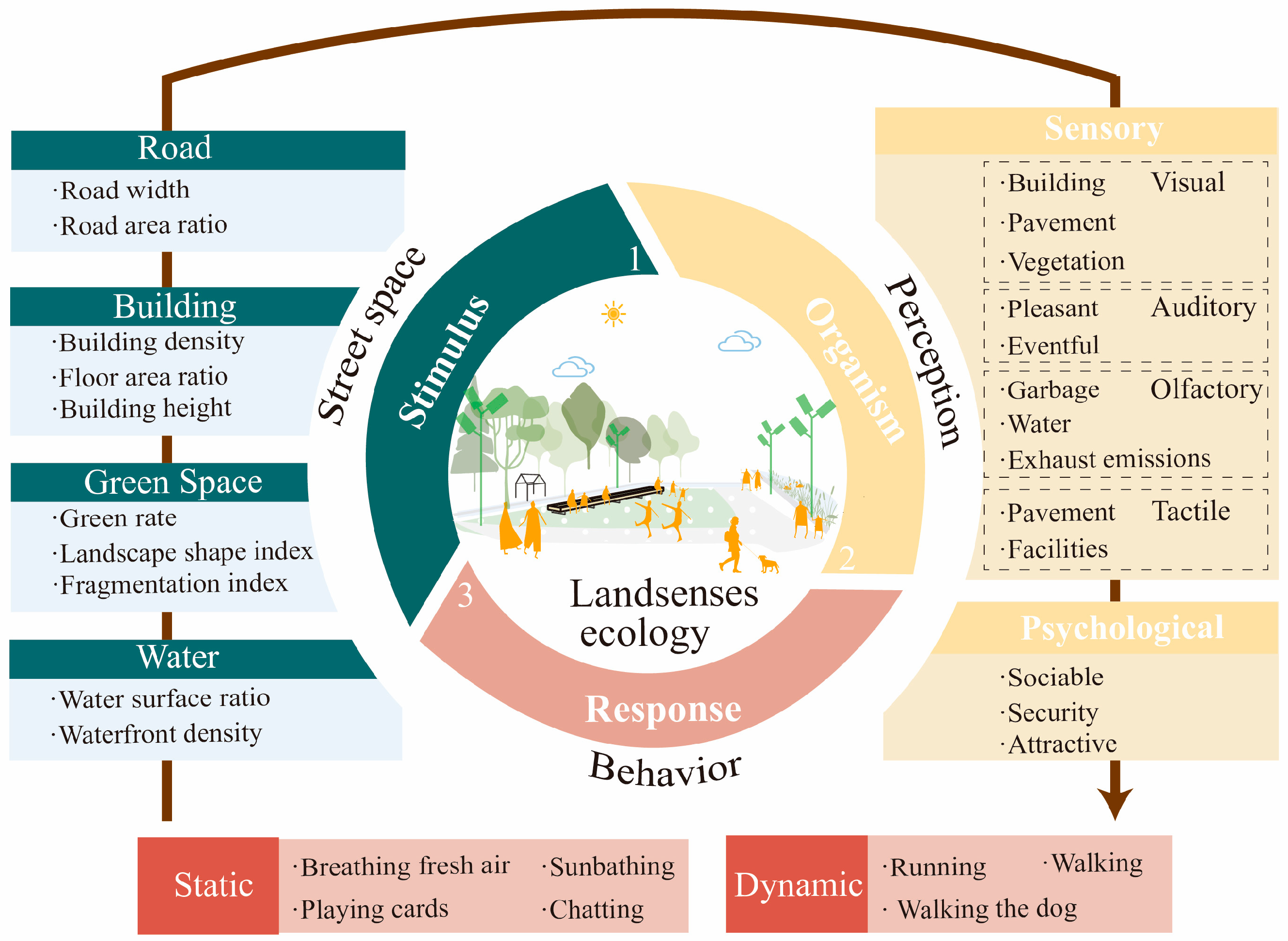
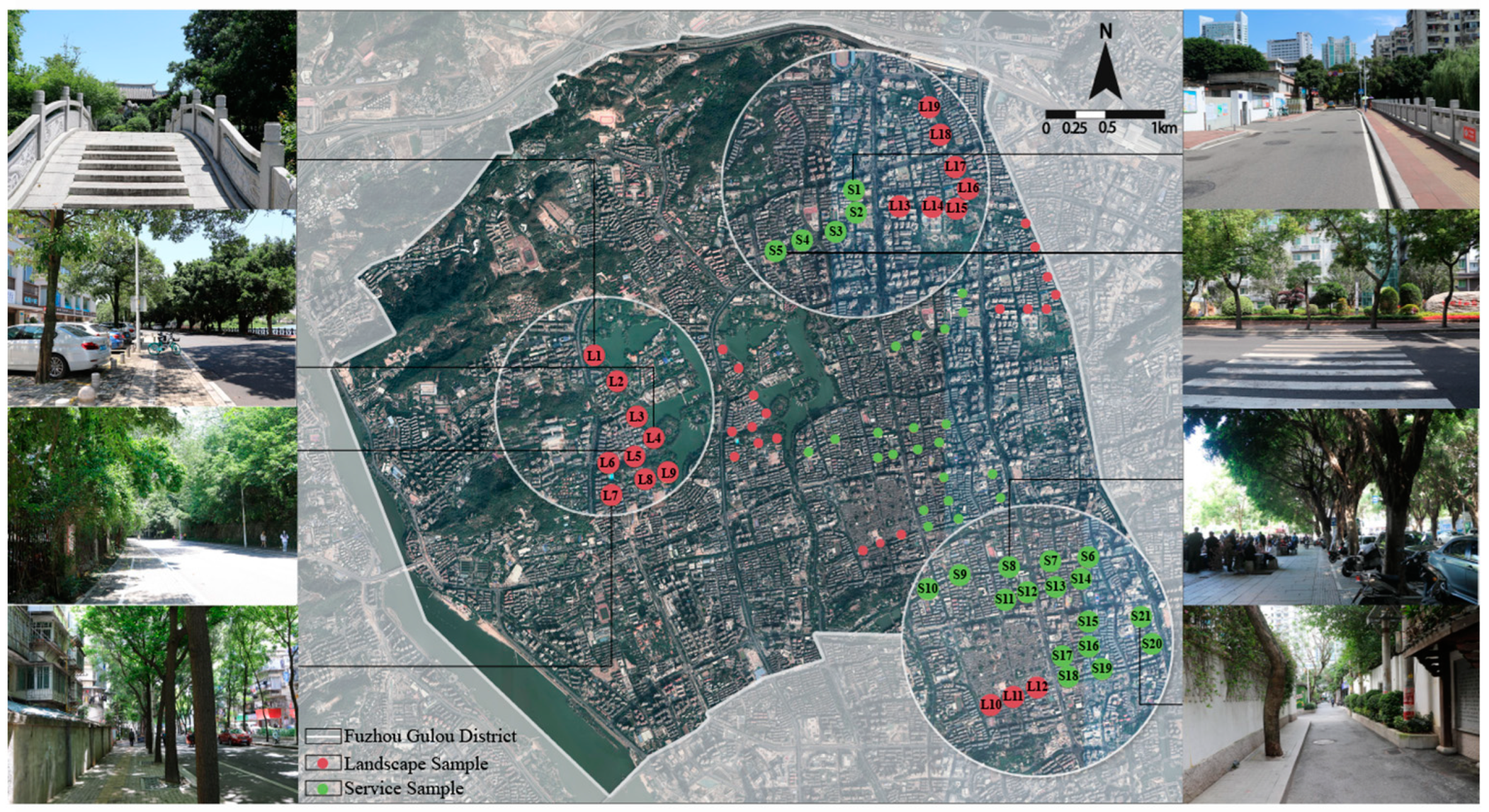
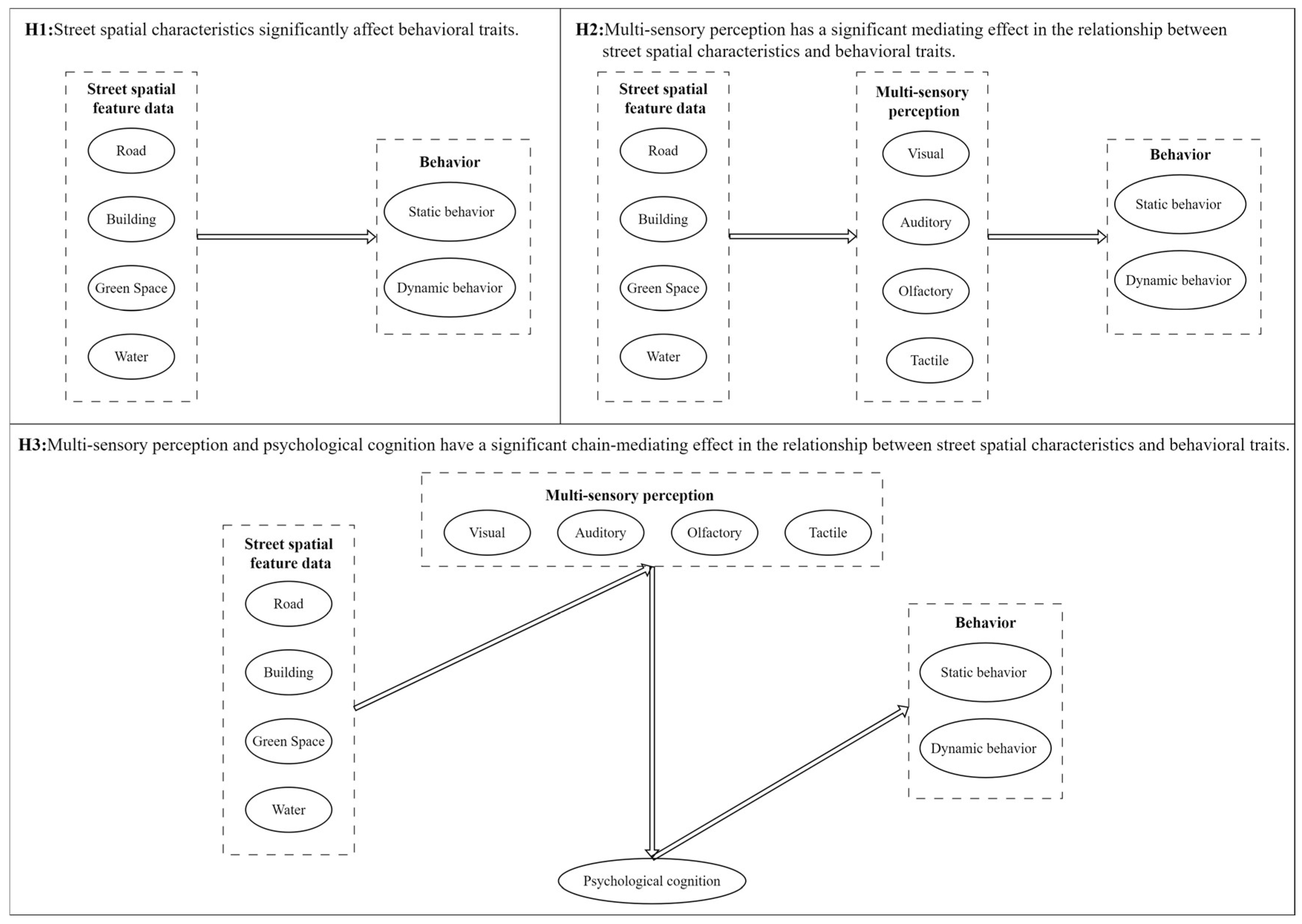
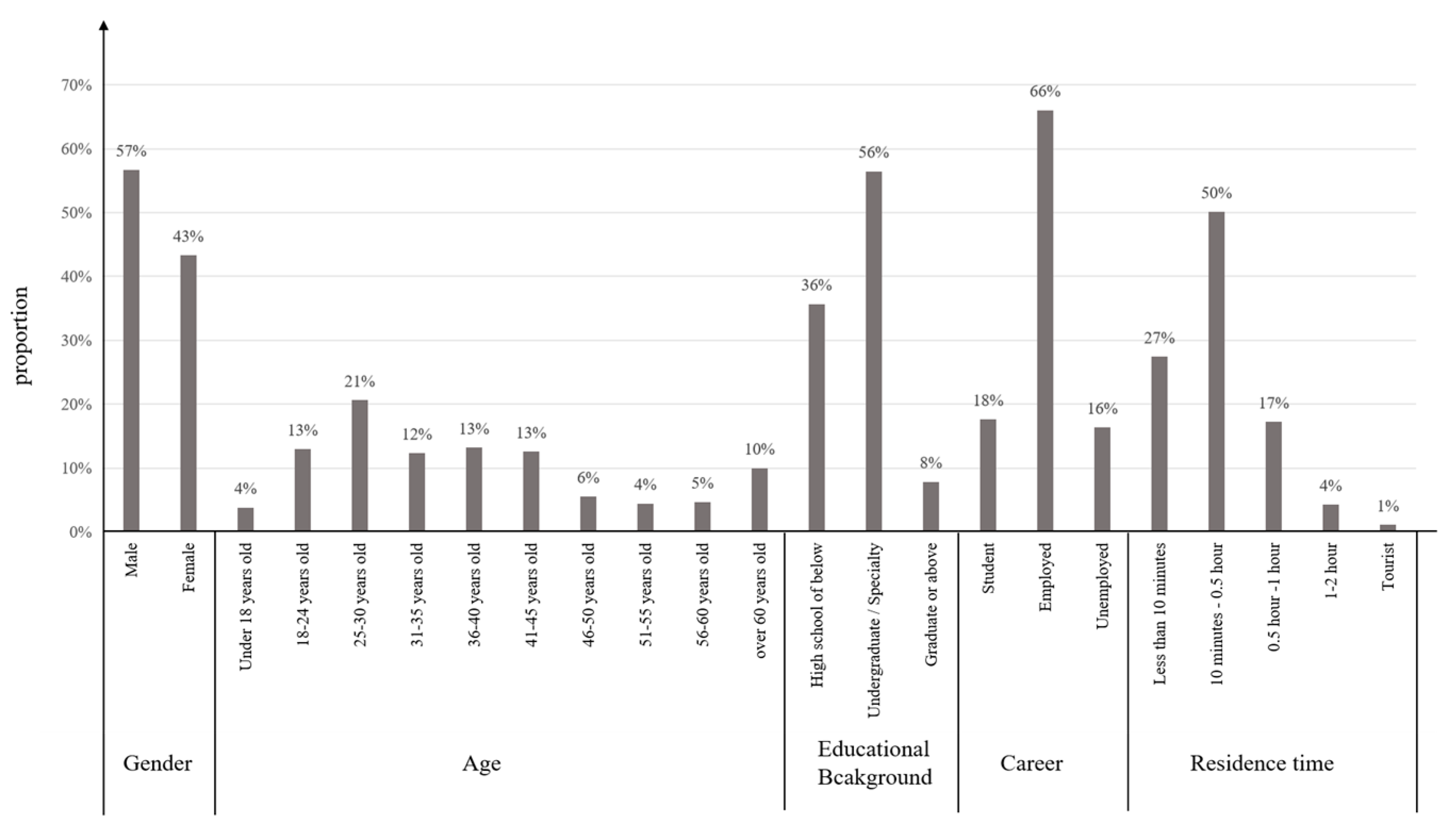
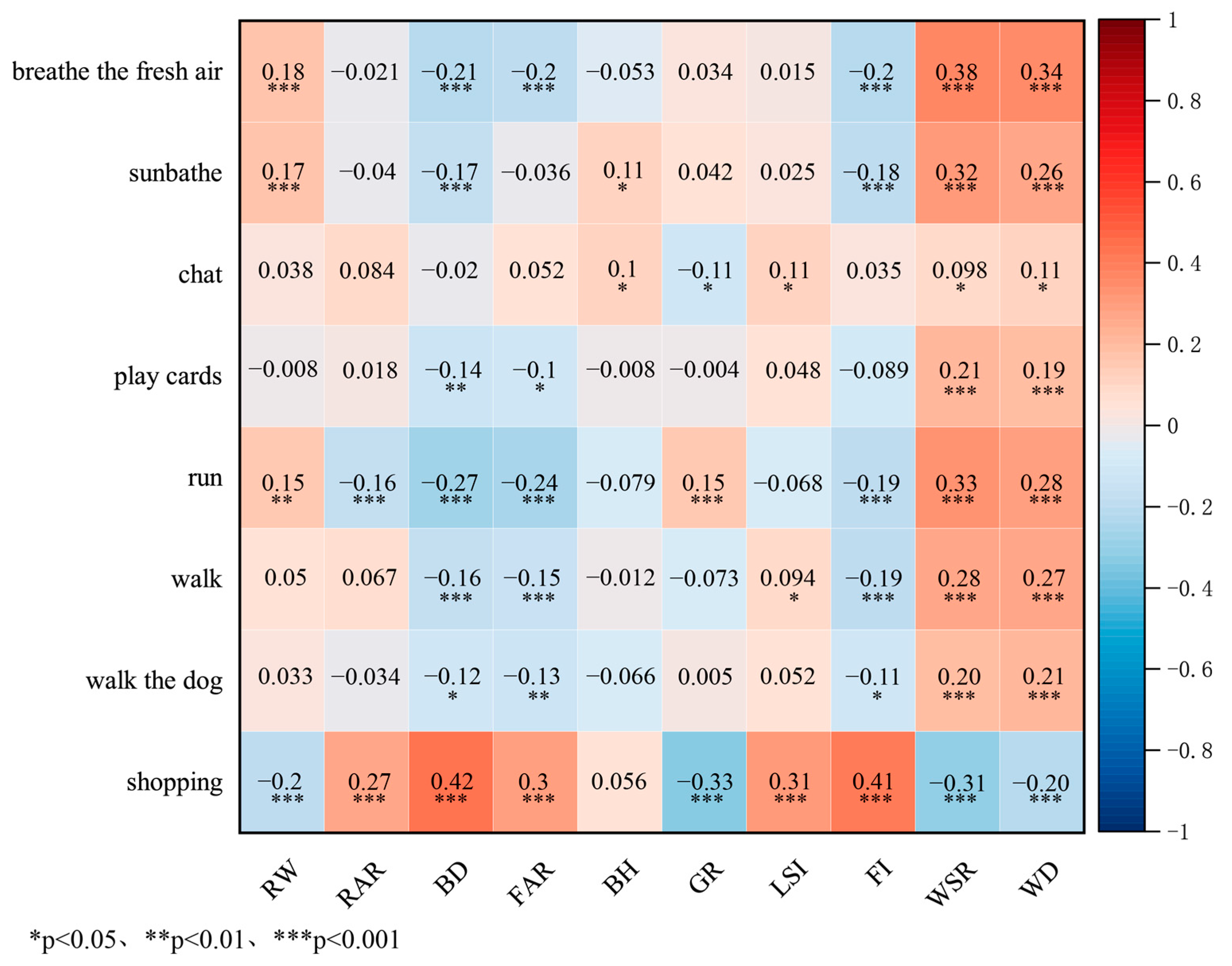
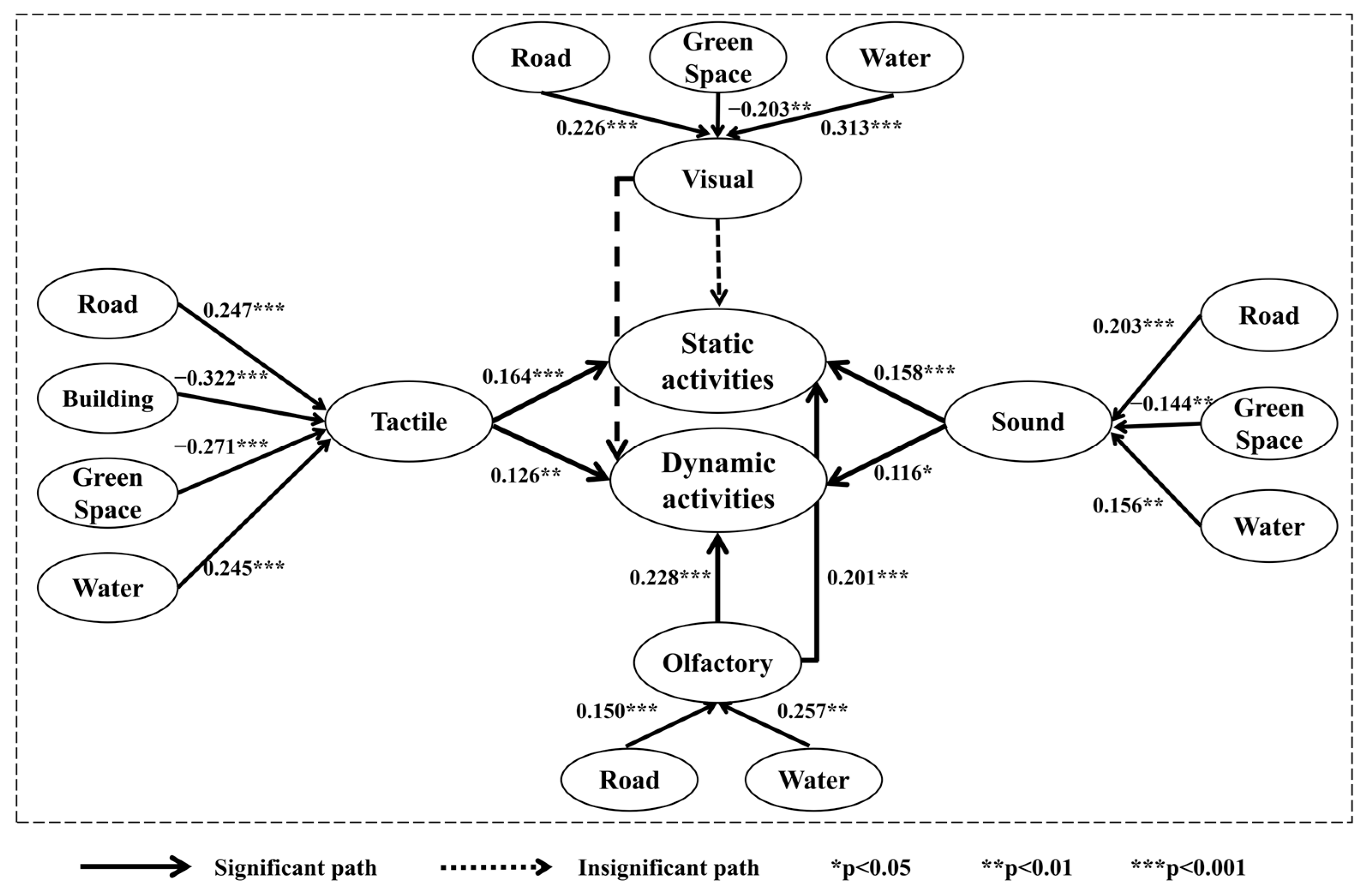
| Elements | Indicators | Calculation Formula | Explanation |
|---|---|---|---|
| Road | Road Width (RW) | Dv denotes the width of the vehicle lane. Ds represents the width of the sidewalk. | |
| Road Area Ratio (RAR) | Sr denotes the road surface area within the buffer zone. S denotes the total area within the buffer zone. RAR calculation in this study mainly includes urban main roads and side roads, excluding roads within residential areas. | ||
| Building | Building Density (BD) | Sg denotes the ground floor area within the buffer zone. | |
| Floor Area Ratio (FAR) | Sb denotes the total building area within the buffer zone. | ||
| Building Height (BH) | Hi denotes the height of the i-th building within the buffer zone, while n denotes the number of buildings within the buffer zone. | ||
| Green Space | Green Rate (GR) | Sg denotes the total area of green space within the buffer zone. | |
| Landscape Shape Index (LSI) | Cg denotes the total perimeter of green space within the buffer zone. | ||
| Fragmentation Index (FI) | Ni denotes the number of patches within the buffer zone corresponding to the i-th green area, while represents the area of the i-th green space within the buffer zone. | ||
| Water | Water Surface Ratio (WSR) | Sw denotes the total area of water within the buffer zone. WSR refers to the proportion of the water surface area within the buffer zone—including lakes, rivers, and artificial ponds—relative to the total area of the buffer zone. | |
| Waterfront Density (WD) | Cw denotes the perimeter of the water’s edge within the buffer zone. |
| Sensory Perception | Characterization Indicators |
|---|---|
| Visual | The building is colorful. |
| The pavement color is very comfortable. | |
| The vegetation is very lush. | |
| Sound | The soundscape is pleasant. |
| The soundscape is eventful. | |
| Olfactory | Odor of the garbage. |
| Odor of the water. | |
| Odor of automobile exhaust. | |
| Tactile | The pavement is smooth. |
| The rest facilities are well-equipped. | |
| The rest facilities are comfortable. | |
| Psychological | The atmosphere of interaction is well. |
| It has a sense of security. | |
| It is attractive. |
| Behavior Type | Concrete Behavior |
|---|---|
| Static activities | breathe the fresh air, sunbathe, chat, play cards. |
| Dynamic activities | run, walk, walk the dog, shopping |
| Elements | Indicators | Mean | Max | Min | Standard Deviation |
|---|---|---|---|---|---|
| Road | RW/m | 13.9 | 20.0 | 8.3 | 3.0 |
| RAR/% | 41.9 | 66.6 | 12.5 | 13.4 | |
| Building | BD/% | 28.5 | 45.4 | 8.6 | 8.7 |
| FAR | 2.017 | 4.843 | 0.196 | 1.075 | |
| BH/m | 24.499 | 50.267 | 5.279 | 9.542 | |
| Green Space | GR/% | 35.5 | 64.2 | 20.5 | 12.0 |
| LSI | 11.367 | 20.732 | 5.417 | 3.713 | |
| FI/% | 0.106 | 0.299 | 0.009 | 0.074 | |
| Water | WSR/% | 0.079 | 0.345 | 0.000 | 0.113 |
| WD/% | 0.856 | 3.642 | 0.000 | 1.121 |
| Indicator | Gender | Age | Educational Background | Career | Residence Time | |
|---|---|---|---|---|---|---|
| Visual | Building | 0.054 | 0.086 | 0.312 | 0.262 | 0.378 |
| Pavement | 0.711 | 0.212 | 0.847 | 0.243 | 0.004 ** | |
| Vegetation | 0.194 | 0.576 | 0.247 | 0.192 | 0.851 | |
| Sound | Pleasantness | 0.358 | 0.268 | 0.027 * | 0.052 | 0.488 |
| Eventfulness | 0.558 | 0.990 | 0.146 | 0.842 | 0.476 | |
| Olfactory | Garbage | 0.590 | 0.094 | 0.024 * | 0.012 * | 0.878 |
| Water | 0.632 | 0.316 | 0.381 | 0.936 | 0.521 | |
| Automobile | 0.64 | 0.263 | 0.042 * | 0.871 | 0.360 | |
| Tactile | Pavement | 0.551 | 0.101 | 0.058 | 0.171 | 0.177 |
| Well-equipped facilities | 0.039 * | 0.091 | 0.063 | 0.033 * | 0.878 | |
| Comfortable facilities | 0.268 | 0.274 | 0.186 | 0.440 | 0.787 | |
| Psychological | Interaction | 0.045 * | 0.125 | 0.318 | 0.050 * | 0.748 |
| Security | 0.007 ** | 0.349 | 0.207 | 0.488 | 0.712 | |
| Attraction | 0.257 | 0.247 | 0.187 | 0.076 | 0.279 | |
| Behavior | Gender | Age | Educational Background | Career | Residence Time | |
|---|---|---|---|---|---|---|
| Static activity | breath the fresh air | 0.998 | 0.004 ** | 0.001 ** | 0.000 *** | 0.287 |
| chat | 0.024 * | 0.138 | 0.001 ** | 0.575 | 0.840 | |
| play cards | 0.026 * | 0.002 ** | 0.000 *** | 0.000 *** | 0.487 | |
| sunbathe | 0.008 ** | 0.011 * | 0.000 *** | 0.005 ** | 0.460 | |
| Dynamic activities | walk the dog | 0.952 | 0.006 ** | 0.005 ** | 0.015 * | 0.501 |
| run | 0.282 | 0.015 * | 0.012 * | 0.092 | 0.348 | |
| walk | 0.829 | 0.002 ** | 0.012 * | 0.000 *** | 0.552 | |
| shopping | 0.441 | 0.061 | 0.032 * | 0.024 * | 0.668 | |
| Type | Dependent Variable | Independent Variable | Beta | VIF | t | R2 | F |
|---|---|---|---|---|---|---|---|
| Static activity | Breathe the fresh air | RW | 0.138 | 1.479 | 2.716 ** | 0.186 | 21.226 *** |
| FAR | −0.137 | 1.68 | −2.525 * | ||||
| GR | −0.186 | 1.41 | −3.738 *** | ||||
| WSR | 0.213 | 3.134 | 2.884 ** | ||||
| WD | 0.147 | 2.508 | 2.214 * | ||||
| chat | GR | −0.134 | 1.005 | −2.944 *** | 0.039 | 9.397 *** | |
| WD | 0.154 | 1.005 | 3.387 ** | ||||
| play cards | WD | 0.268 | 1.000 | 6.020 *** | 0.072 | 36.242 *** | |
| sunbathe | GR | −0.116 | 1.073 | −2.588 ** | 0.129 | 34.533 *** | |
| WSR | 0.371 | 1.073 | 8.299 *** | ||||
| Dynamic activities | walk the dog | WD | 0.229 | 1.000 | 5.102 ** | 0.053 | 26.028 *** |
| Run | BD | −0.206 | 1.159 | −4.388 *** | 0.108 | 2.128 *** | |
| WD | 0.191 | 1.159 | 4.059 *** | ||||
| walk | FAR | −0.194 | 1.415 | −3.823 *** | 0.150 | 27.500 *** | |
| GR | −0.284 | 1.261 | −5.92 *** | ||||
| WSR | 0.279 | 1.215 | 5.939 *** | ||||
| shopping | RAR | 0.149 | 1.261 | 3.239 ** | 0.218 | 32.386 *** | |
| BD | 0.198 | 2.287 | 3.2 ** | ||||
| GR | −0.129 | 1.497 | −2.58 * | ||||
| WSR | −0.14 | 1.793 | −2.556 * |
| Dependent Variable | Independent Variable | Direct Effect | Indirect Effect | ||||
|---|---|---|---|---|---|---|---|
| Estimates (β) | p | 95%CI | Estimates (β) | p | 95%CI | ||
| Static activity | Road | −0.091 | 0.023 | [−0.172,−0.015] | 0.141 | 0.001 | [0.098,0.192] |
| Building | 0.032 | 0.652 | [−0.108,0.169] | −0.087 | 0.008 | [−0.155,−0.024] | |
| Green space | −0.075 | 0.080 | [−0.158,0.010] | −0.095 | 0.001 | [−0.151,−0.044] | |
| Water | 0.192 | 0.001 | [0.081,0.304] | 0.176 | 0.001 | [0.109,0.248] | |
| Dynamic activities | Road | −0.100 | 0.022 | [−0.187,−0.013] | 0.097 | 0.000 | [0.057,0.144] |
| Building | −0.053 | 0.470 | [−0.199,0.090] | −0.054 | 0.040 | [−0.103,−0.001] | |
| Green space | 0.020 | 0.716 | [−0.083,0.129] | −0.055 | 0.015 | [−0.101,−0.011] | |
| Water | 0.127 | 0.039 | [0.004,0.246] | 0.121 | 0.001 | [0.058,0.198] | |
| Influence Path | Estimates (β) | p | 95%CI |
|---|---|---|---|
| Road -> tactile perception -> psychological cognition -> static activity | 0.014 | 0.015 | [0.004,0.027] |
| Building -> tactile perception -> psychosocial cognition -> static activity | −0.019 | 0.015 | [−0.035,0.005] |
| Green space -> tactile perception -> psychological cognition -> static activity | −0.016 | 0.018 | [−0.031,−0.005] |
| Water -> tactile perception -> psychological cognition -> static activity | 0.014 | 0.025 | [0.004,0.028] |
| Water -> visual perception -> psychological cognition -> static activity | 0.006 | 0.045 | [0.001,0.013] |
Disclaimer/Publisher’s Note: The statements, opinions and data contained in all publications are solely those of the individual author(s) and contributor(s) and not of MDPI and/or the editor(s). MDPI and/or the editor(s) disclaim responsibility for any injury to people or property resulting from any ideas, methods, instructions or products referred to in the content. |
© 2024 by the authors. Licensee MDPI, Basel, Switzerland. This article is an open access article distributed under the terms and conditions of the Creative Commons Attribution (CC BY) license (https://creativecommons.org/licenses/by/4.0/).
Share and Cite
Han, T.; Tang, L.; Liu, J.; Jiang, S.; Yan, J. The Influence of Multi-Sensory Perception on Public Activity in Urban Street Spaces: An Empirical Study Grounded in Landsenses Ecology. Land 2025, 14, 50. https://doi.org/10.3390/land14010050
Han T, Tang L, Liu J, Jiang S, Yan J. The Influence of Multi-Sensory Perception on Public Activity in Urban Street Spaces: An Empirical Study Grounded in Landsenses Ecology. Land. 2025; 14(1):50. https://doi.org/10.3390/land14010050
Chicago/Turabian StyleHan, Tianqi, Lina Tang, Jiang Liu, Siyu Jiang, and Jinshan Yan. 2025. "The Influence of Multi-Sensory Perception on Public Activity in Urban Street Spaces: An Empirical Study Grounded in Landsenses Ecology" Land 14, no. 1: 50. https://doi.org/10.3390/land14010050
APA StyleHan, T., Tang, L., Liu, J., Jiang, S., & Yan, J. (2025). The Influence of Multi-Sensory Perception on Public Activity in Urban Street Spaces: An Empirical Study Grounded in Landsenses Ecology. Land, 14(1), 50. https://doi.org/10.3390/land14010050








